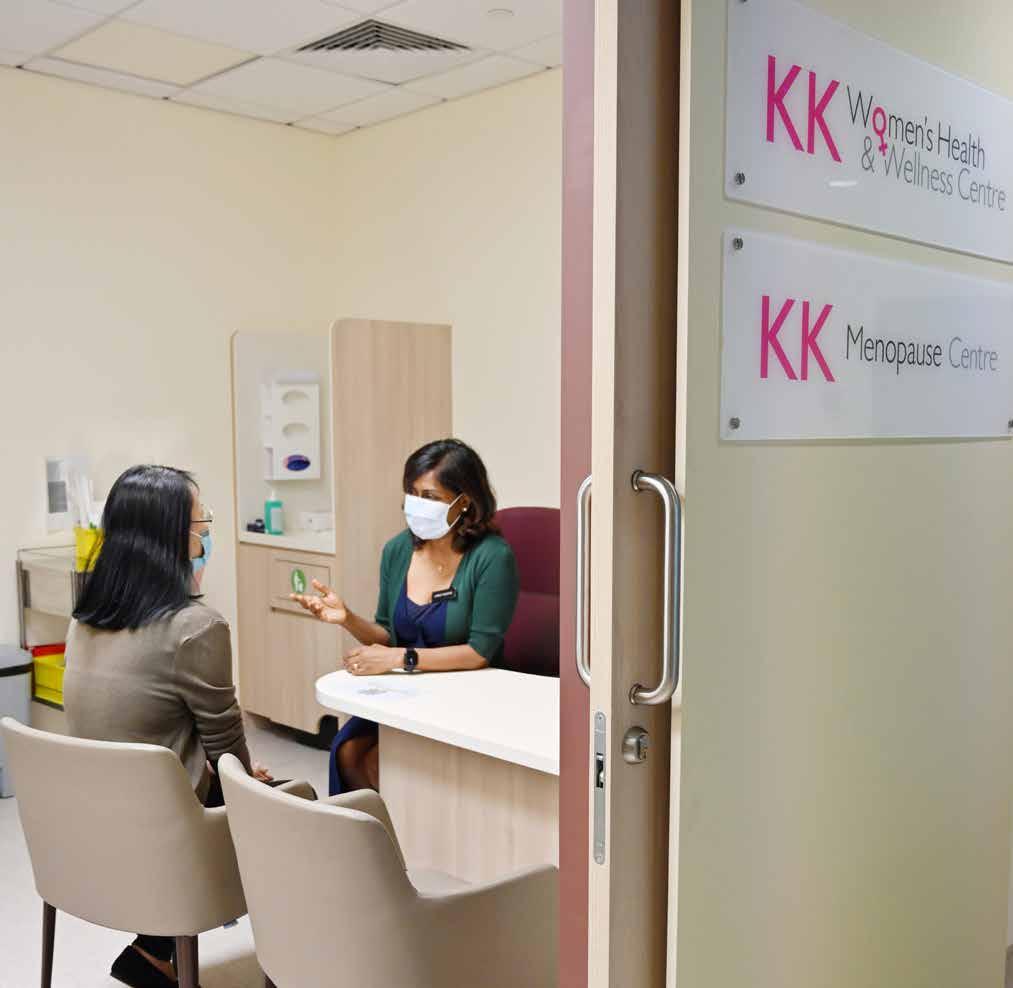
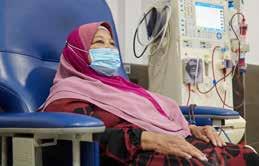
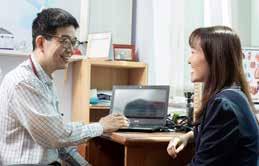


THE FLAGSHIP PUBLICATION OF THE SINGHEALTH DUKE-NUS ACADEMIC MEDICAL CENTRE Mar-Apr 2024 www.sgh.com.sg www.singhealth.com.sg MCI (P) 002/07/2023 Read more on page 02 Receive latest updates via our free electronic mailer. Scan the QR code and subscribe now! 15 HealthWatch Just two cups of kopi can keep Parkinson’s disease at bay InFocus Dialysis patients can now get blocked catheters cleared at NKF centres 05 12 BeWellwithSingHealth Bridging care across community with Partners Buddy Multidisciplinary care for women undergoing menopause The KK Menopause Centre offers holistic care for women during and after ‘the change’

PUBLISHERS

CO-PUBLISHERS
®
CONTENT ADVISORS
Audrey Lau, Jennifer Wee
EDITORIAL TEAM
Lim Mui Khi, Domenica Tan, Jenny Ang, Celine Sim
Read Singapore Health online at www.singhealth.com. sg/singaporehealth
PUBLISHING AGENT
ThinkFarm Pte Ltd
Managing Director Christopher Tay
Head, Editorial Chua Kim Beng
Head, Creative Lee Lily
Head, Client Relationship
Jessie Kek
For advertising enquiries, please call 6831 1299 or email advertise@thinkfarm.sg
All rights reserved. Copyright by Singapore Health Services Pte Ltd (registration no.: 200002698Z). Opinions expressed in Singapore Health are solely those of the writers and are not necessarily endorsed by SGH, SingHealth Group and/or Thinkfarm Pte Ltd (registration no.: 201226362G), and their related companies. They are not responsible or liable in any way for the contents of any of the advertisements, articles, photographs or illustrations contained in this publication. Editorial enquiries should be directed to the Editor, Singapore Health, 168 Jalan Bukit Merah, #13-01 Surbana One, Singapore 150168, or email: singaporehealth@singhealth.com.sg.
Unsolicited material will not be returned unless accompanied by a self-addressed envelope and sufficient return postage. While every reasonable care will be taken by the Editor, no responsibility is assumed for the return of unsolicited material.
ALL INFORMATION CORRECT AT TIME OF PRINTING. MCI (P) 002/07/2023. Printed in Singapore by Times Printers Pte Ltd (registration no.: 196700328H).
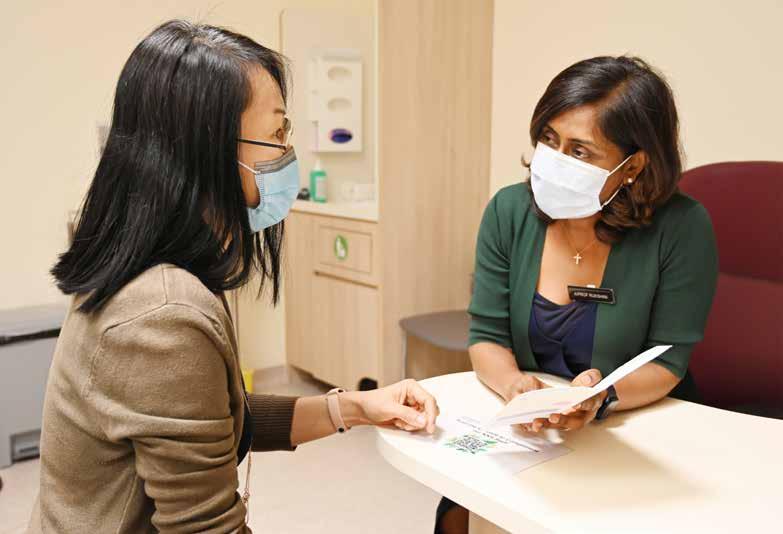
Comprehensive menopause care
KK Menopause Centre offers holistic treatment and support for women during and beyond their menopause.
by Goh Bee Lian
The KK Menopause Centre, opened in October 2023, aims to holistically address various aspects of menopause — physical, emotional, mental and sexual — as well as chronic disease screening and disease prevention.
When menopause struck, Ms X, who works in the service sector, experienced hot flushes, night sweats, and mood swings. Having hot flushes while dealing with customers embarrassed her so much that she contemplated leaving her job. Unlike her usual cheerful demeanour, she often got angry over minor issues. Unable to manage her symptoms and feelings of guilt for venting on family members, Ms X sought help from KK Women’s and Children’s Hospital (KKH).
Menopause is a natural process where the ovarian function gradually declines and permanently stops due to age or when both ovaries are surgically removed. Every woman’s menopause experience is unique — some go through this period with little to no issues, while others may experience hormonal changes that result in hot flushes, sleep disturbances, mood disorders, and sexual dysfunction. Navigating this period can be daunting and isolating.
“Few women seek support for menopause as they are convinced that this is just a phase. For those who do, they traditionally turn to a gynaecologist. This alone may not be sufficient, as they usually have nongynaecological-related symptoms, including body aches, weight gain, skin rashes, and mood changes,” said Associate Professor Rukshini Puvanendran, Head and Senior Consultant, Family Medicine Service, KKH. Assoc Prof Rukshini is also Co-Director of the KK Menopause Centre, a multidisciplinary clinic staffed by specialists in gynaecology, dermatology, family medicine, and mental health.
Opened in October 2023, it aims to holistically address various aspects of menopause — physical, emotional, mental and sexual — as well as chronic disease screening and disease prevention. The centre provides interventions such as advice on lifestyle adjustments, hormonal therapy, and non-hormonal therapy. Together with counselling and patient education, it aims to increase women’s awareness of menopause and promote
02 CoverStory
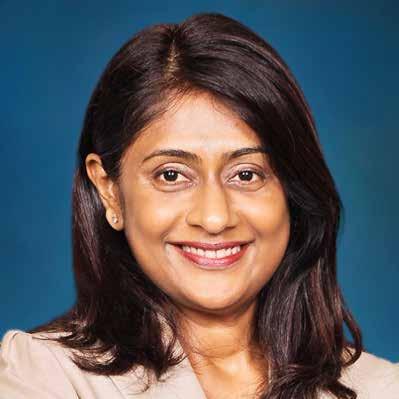
We encourage all women who have experienced moderate to severe menopausal symptoms to seek a detailed consultation to assess their suitability for MHT.
Associate Professor Rukshini
Puvanendran Co-Director,
KK Menopause Centre; Head and Senior Consultant, Family Medicine Service;
KK
Women’s and Children’s Hospital
women’s general well-being and healthier ageing.
The most effective treatment for menopausal symptoms is menopause hormone therapy (MHT), shared Assoc Prof Rukshini. Data showed that the five-year use of MHT in women in their 50s has several beneficial effects, such as reducing heart disease, fractures, and allcause mortality, including cancer mortality. MHT has been shown to be safe and effective in most women.
Like any medication, MHT can cause side effects, including transient breast tenderness and nausea. Some women may experience unexpected vaginal bleeding or spotting. Longer-term use of MHT has been associated with a slight increase in the risk of breast cancer.
“We encourage all women who have experienced moderate to severe menopausal symptoms to seek a detailed consultation to assess their suitability for MHT,” said Assoc Prof Rukshini. The benefits and risks of taking MHT depend on a woman’s age, menopausal symptoms, and any risk factors she may have. In women under the age of 60 with bothersome menopausal symptoms and at low risk of breast cancer and blood clots, the benefits of MHT likely outweigh the risks, she added.
For Ms X, who received MHT and counselling to address her symptoms,
Tips for managing menopausal symptoms
Wear thin/light and breathable clothing
Use portable fans for quick relief
Air condition or ventilate your living spaces
Exercise regularly to help regulate hormones, improve mood, promote better sleep, and enhance general well-being
Avoid trigger foods such as fried and spicy dishes
Establish good sleep hygiene such as consistent sleep schedule and comfortable sleep environment
Practise relaxation techniques including deep breathing, meditation and yoga
Maintain a healthy body weight
Maintain a healthy balanced diet rich in vegetables, whole grains, and lean protein
Quit smoking
Seek professional medical help if symptoms impact your quality of life
Share your concerns with friends, family members or healthcare professionals for emotional support and valuable insights
Spend quality time with loved ones
Join a support group for a sense of belonging and to reduce stress
her symptoms improved. “When she came back for her follow-up appointment, she was back to her former cheerful self. She has been maintaining this status since and is on regular follow-ups to ensure that she stays in optimal health,” shared Advanced Practice Nurse (APN) Chua Mei Tuan, Nurse Clinician, Family Medicine Service, KKH. APN Chua encourages family members of menopausal women to familiarise themselves with the changes that their loved ones may be going through so that they understand the physical and emotional changes that their loved ones may be experiencing and can provide better support.
“Patients of KKH can join the Dynamite Daisies menopause interest group so that we can journey with them,” APN Chua said. The interest group aims to promote awareness of general women’s health and support for women undergoing menopause transitions. Together with its panel of medical specialists, the group organises educational talks, events and activities related to women’s health. It is a platform for women to share their menopause experiences and tips to overcome symptoms. Members of the interest group meet every three to four months. For more information about the group, email to familymedicineservice@kkh.com.sg
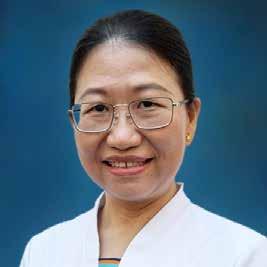
Patients of KKH can join the Dynamite Daisies menopause interest group so that we can journey with them.
Ms Chua Mei Tuan Advanced Practice Nurse (APN), Nurse Clinician, Family Medicine Service, KK Women’s and Children’s Hospital
03
Standing and walking on their own two feet again
A multidisciplinary team comprising members from NNI, TTSH and A*STAR has found a way to restore movement in patients paralysed from the chest down.
by Thava Rani
When he was flung off his horse during training, competitive jockey Mr Sam Subian fractured his spine and was told he would never stand or walk again. He was devastated. That was six years ago. Now, thanks to an implant and a whole lot of hard work and determination, Mr Sam is starting to walk again.
The implant and intensive rehabilitation programme he underwent were part of RESTORES (restoration of rehabilitative function with epidural spinal stimulation), a clinical trial conducted by the National Neuroscience Institute (NNI), Tan Tock Seng Hospital (TTSH), and the Agency for Science, Technology and Research (A*STAR). It is the first of its kind in the region.
“It took me a while to accept my situation. Just as I was coming out of a low point, I was told about the trial. I didn’t hesitate at all to sign up,” said Mr Sam, who is the first of three participants in the trial. All three suffered complete spinal cord injuries.
When the spinal cord is damaged, transmission of electrical signals to and from the brain is disrupted. “Depending on which part of the spinal cord is severed, patients will not be able to move their arms and legs, or have any sensation below the level of the injury,” said Dr Wan Kai Rui, Consultant, Department of Neurosurgery, NNI.
Together, NNI and TTSH treat about 100 new cases of spinal cord injury a year, and about 95 per cent of them with severe injuries show no neurological improvement five years after their injury. But having an implant — an electrode placed on the surface of the spinal cord near the damaged area — can help patients overcome this.
“The spinal cord stimulator helps bridge the damaged part of the spinal cord and boost signals from the brain to the muscles by tapping residual pathways that are still viable,” said Dr Wan, who is also the principal investigator of the trial.
However, the implant alone is not enough; rehabilitation is also vital.
Prior to the implant operation, Mr Sam underwent one month of twice-weekly rehabilitation to strengthen his limbs and core. After recuperating for a month postsurgery, he was back again for rehabilitation five times a week for seven months.
In the past, patients with spinal cord injuries also underwent rehabilitation, but it was mostly to help them cope with their disability. “What we are doing now
is restorative rehabilitation, where we are actually working on restoring function,” said Dr Valerie Ng, Consultant, Department of Rehabilitation Medicine, TTSH, and co-principal investigator of the study.
Various techniques of rehabilitation were used in this trial. These included motor imagery, where patients imagine a movement although they cannot actually perform the physical movement; truncal rehabilitation and an advanced robotic exoskeleton, where patients use a suit to hold them upright and ‘walk’ the legs so that their dormant muscles can be reactivated. By recording and analysing signals from the muscles, researchers noted a significant improvement in nerve function and muscle activity in these patients.
The second participant, financial adviser Mr Asyraf Ghazali, was in a road accident five years ago. Just like Mr Sam, he was paralysed from the chest down. “I was not ready to accept it and was continuously looking for treatments to help me walk again,” he said.
Although Mr Asyraf found one in Thailand, they were not accepting patients with complete impairment of the spinal cord. “So the moment I was offered the opportunity to be on the clinical trial, I jumped on it,” he stated. Mr Asyraf received his implant in
March 2023, a month after Mr Sam.
The third participant, a woman, had an electrode implanted in January 2024.
Both men were up and taking their first steps and walking within a month of starting rehabilitation. “But because they have not walked for so long, we had to work on strengthening their muscles during the remaining five to six months so that they can support their own weight and be off the safety harness,” added Dr Wan.
While they are able to move, they cannot feel themselves moving and were therefore initially sceptical. “I just put the movements down to spasms. But as the rehab progressed, the greatest thing was to see movements I didn’t think were possible,” said Mr Asyraf.
With the success stories so far, the multidisciplinary team intends to move into the next phase of the trial with about 15 patients. “We will be looking at those with paralysis from the neck down. We hope that the electrode stimulation can also help with functional improvement of their arms,” shared Dr Wan.
For Mr Sam, his experience has shown him that what appears to be an irreparable situation can still turn around. “Hopefully, this will inspire others to not lose hope.”
“The spinal cord stimulator helps bridge the damaged part of the spinal cord and boost signals from the brain to the muscles by tapping residual pathways that are still viable,” says Dr Wan Kai Rui.

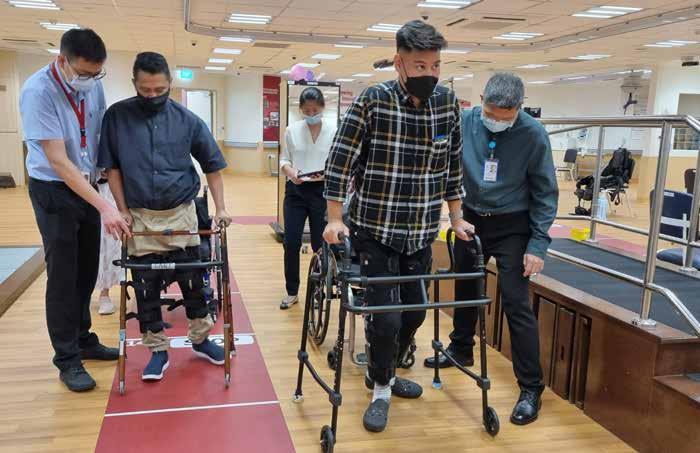
04 InFocus
Mr Asyraf (right) and Mr Sam taking steps with the help of walking frames. “Hopefully, this implant will inspire others to not lose hope,” says Mr Sam.
Since NKF nurses were trained on CLEAR procedures, Mdm Mesum Reswat, 71, has had her dialysis catheter unblocked at Marsiling Dialysis Centre at least twice instead of having to travel to SGH to have the procedure done.

CLEARing catheter blockages at dialysis centres
Over 100 nurses at NKF dialysis centres have been trained to clear central venous catheter blockages. This saves patients with less complex issues the effort and expense of having to seek treatment at a hospital.
by Goh Bee Lian
When kidney failure patients’ dialysis catheter is blocked, they usually visit hospitals for treatment. This can take three to six days of hospitalisation, with dialysis disrupted as well.
However, a new service by Singapore General Hospital (SGH) and the National Kidney Foundation (NKF) allows patients to have their catheter unblocked at NKF dialysis centres — and to resume dialysis on the same day.
Dr Tan Ru Yu, Senior Consultant, Department of Renal Medicine, SGH, and the project’s co-lead, said: “With the right-siting of care, patients can receive treatment for their blocked catheters at the dialysis centre they go to and proceed with dialysis at the centre right after without having to make their way to the hospital. Our partnership with NKF has also enabled SGH to focus on complex cases requiring immediate attention.”
The other project co-lead is Associate Professor Jason Choo, Medical Director, NKF, and Senior Consultant, Department of Renal Medicine, SGH.
In Singapore, over 300,000 patients suffer from chronic kidney disease, but another 200,000 cases may be undetected as
the patients have not undergone the blood tests needed to confirm that they have a kidney problem. Nationwide, about 8,700 kidney failure patients are on dialysis, with six new patients diagnosed every day.
The kidneys are important organs that remove excess fluids and toxins, control blood pressure, and encourage the production of red blood cells. When the kidneys fail and cannot do their work properly, dialysis can perform the function of removing excess fluids and toxins from the body. Fluid and toxin buildup can lead to death.
In haemodialysis, an access has to be created for the blood to be drawn. Some patients use a central venous catheter inserted into a large vein in the neck, chest, or groin for dialysis to be done. The catheter can become blocked due to the formation of blood clots.
When this occurs, patients are usually referred to hospitals’ emergency department. They are then admitted to a ward and administered with thrombolytic agents to break up or dissolve the blood clots. These patients would then need to wait for an available slot for dialysis at the hospital.
If dialysis is successful, the patient is discharged the following day, which means an average hospital stay of three days.
If the blood is still not flowing smoothly
through the catheter after the procedure, the patient will have to undergo a catheter replacement and dialysis before being discharged. With the waiting times for the various procedures, the patient’s hospital stay can be as long as six days.
In addition to delayed haemodialysis and disruption to a patient’s routine, a trip to the hospital means additional travel time and hospitalisation costs. For the hospital, such cases add to congestion and care demands at the emergency department. SGH sees about 100 patients yearly for blocked catheters.
The SGH-NKF Catheter Flow Restoration with Lytic Dwell at Community Dialysis Centre project (CLEAR) was launched in December 2022. Since then, SingHealth nephrologists have trained more than 100 NKF nurses to administer the treatment, said Ms Lucy Lu, Senior Nurse Manager, NKF.
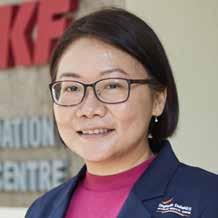
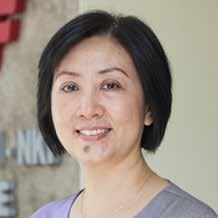
“Our partnership with NKF has enabled SGH to focus on complex cases requiring immediate attention,” says Dr Tan Ru Yu (top). Ms Lucy Lu (above) says that more than 100 NKF nurses have been trained in the CLEAR initiative.
The doctors training the nurses include Dr Tan, Dr Pang Suh Chien, Senior Consultant, Department of Renal Medicine, SGH, and Dr Charles Ng, Associate Consultant, Renal Medicine Department, Changi General Hospital (CGH).
NKF, the largest dialysis provider in Singapore, operates 41 centres for some 4,642 patients, or 60 per cent of all haemodialysis patients in Singapore.
Of these, more than 700 patients undergo dialysis via a central venous catheter.
Before the implementation of CLEAR, some 50 patients were referred to a hospital every month for catheter flow issues.
Patients keen to participate in the project are screened for eligibility based on criteria like risk of bleeding. Patients not on the programme will continue to be referred to emergency departments for catheter blockage.
Other public hospitals — CGH, Alexandra Hospital, Khoo Teck Puat Hospital, National University Hospital, Ng Teng Fong General Hospital, Sengkang General Hospital and Tan Tock Seng Hospital — have joined the service, which is supported by the Ministry of Health.
05 InFocus
PHOTO: VERNON WONG
Patients empowered to partake in care delivery
Person-centred care places patients at the heart of their own care journey.
by Sol E Solomon
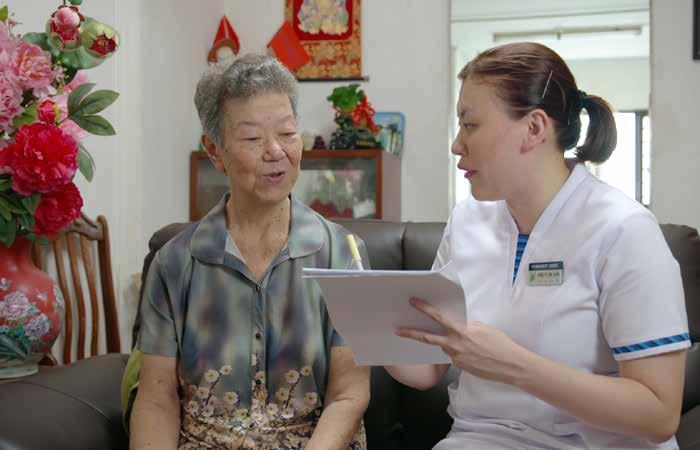
Established in January 2023, CPCC brings together a network of people — including patients and caregivers — and serves to promote PCC awareness and practice through five focus areas: Education, Service Innovation and Translation, User Experience, Research, and Strategic Partnership.
Person-centred care (PCC) has been gaining momentum in recent years as it aligns with changing healthcare perspectives and responds to the evolving needs.
“When patients are empowered to take ownership of their health, there is greater buy-in into their care plan, adherence to their action plans improve, resulting in better health outcomes,” said Ms Esther Lim, Director, SingHealth Centre for PersonCentred Care (CPCC), and Chief Allied Health Professional (Workforce Planning), SingHealth.
The approach works by seeing patients as ‘Experience Experts’ in their own health and care. By recognising that most patients have the capacity to direct and contribute to their own care, it shifts the attention of care providers to look at patients’ strengths, resources, preferences and personal values.
In the PCC model, patients are valuable partners in co-creating care solutions, which are aligned with their goals and lived experiences, thereby empowering them to take on a key role in managing their own health. PCC aims to achieve shared responsibility and shared accountability between patients and their healthcare teams while ensuring a holistic care environment.
Conversations with patients allow healthcare workers to better understand what matters to them, understand what
their goals are, and work together with them to achieve those goals. At the same time, patients should see themselves as part of the solution and be active, equal partners in managing their health instead of being passive recipients of care.
But PCC does not mean that healthcare providers must fulfil everything the patient requests for. It is not personalised medicine, which refers to tailor-made prevention and treatment strategies for defined groups of individuals. It is listening to patients’ perspectives about what matters to them and involving them in all decisions related to their health.
SingHealth’s journey in person-centred care
The groundwork for SingHealth’s PCC initiatives was laid as early as 2016 when the ESTHER Network was introduced in SingHealth. Started in Jönköping, Sweden, in 1997, Esther is a symbolic elderly person who requires close coordination across different care settings to address health and social care needs. This paradigm challenges health and social care providers to rethink how care can be provided in Singapore’s healthcare system by focusing on the patient’s story while identifying what matters to the individual. ESTHER Network Singapore (ENS) endeavours to spread the adoption of PCC approaches in daily practices, as well as system-
level improvement to transform the way healthcare is delivered across care settings.
CPCC, which was launched in January 2023, brings together SingHealth’s PCC initiatives. With its vision “Empowering Individuals. Everyone Matters”, CPCC brings together a network of people — including patients and caregivers — and serves to promote PCC awareness and practice through five focus areas: Education, Service Innovation and Translation, User Experience, Research, and Strategic Partnership.
Milestones in person-centred care
ENS recently won the Public Service Transformation Awards 2023 under the Citizen Engagement Excellence Award category, in recognition of its excellent organisational practice and for its personcentric model of involving patients in their care journey.
Over the past few years, ENS has embarked on several PCC projects, including the Enhanced Recovery After Surgery for Total Knee Replacement, or ERAS TKR, which enables patients to be discharged earlier after total knee replacement surgery. Home visits are initiated after surgery to help patients transition more seamlessly to the home environment. As a result, hospital stays are shortened and patients are well equipped to manage around their own home. The initiative now includes community partners for home visits. It has gained recognition in the National Healthcare Innovation and Productivity (NHIP) 2023 (Best Practice Award) for its innovative and transformative practice.
Another project, Walking with a Star, recognised patients’ wishes to ambulate during their hospitalisation. Patients were afraid of falling when walking during their stay in the hospital. However, they also raised concerns about the discomfort of using diapers as a result of being unable to walk to the washrooms, limited walking aids, and the lack of manpower to assist patients to walk in the wards. In addressing these concerns, appropriate walking aids have since been placed at patients’ bedsides, enabling caregivers, nurses and even volunteers to help them throughout the day.
As our healthcare system evolves, it is of paramount importance that what matters to a patient is considered in the work that we do, whether in clinical care or in planning and projects. Through partnerships with colleagues and patients, CPCC aims to promote and spread the PCC culture and live out the vision of “Empowering Individuals. Everyone Matters”.
06 InFocus
Zapping holes in prostate cancer cells
New non-thermal treatment eliminates small-volume prostate cancer while preserving healthy surrounding tissue very near the prostate.
by Goh Bee Lian
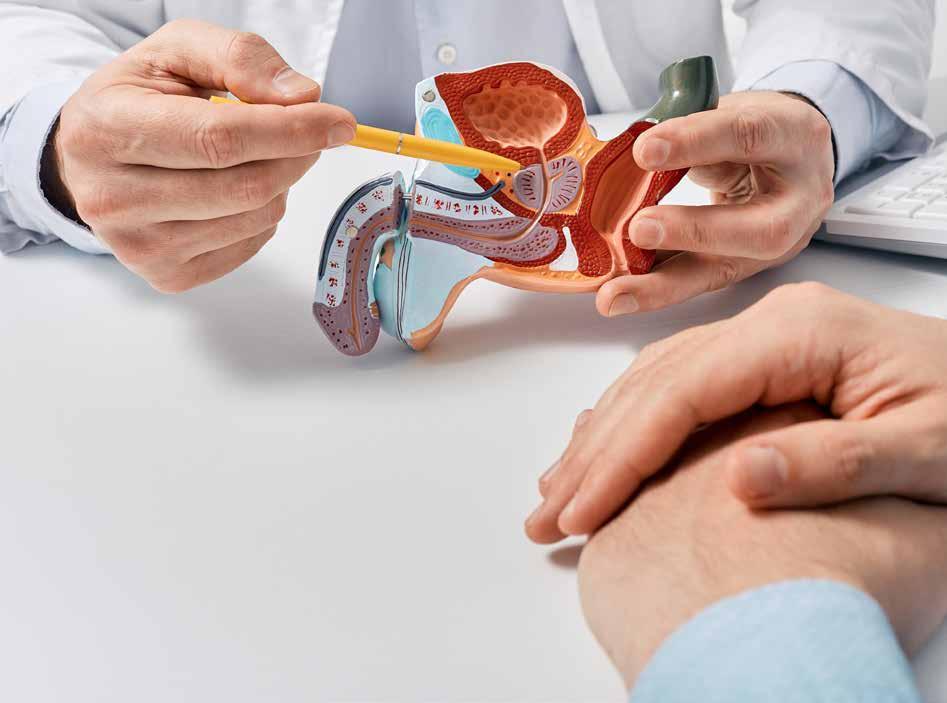
When tests showed that his early-stage prostate cancer had begun growing more aggressively, Mr Tan Kok Wee faced the prospect of having the whole gland removed — and possible permanent side effects of urinary and sexual dysfunction as a result.
This was because the cancer, like 40 per cent of men with the disease, was found too near the urethra — within 1mm — and other vital structures for him to undergo more traditional methods of treatment. However, Mr Tan, in his late 60s, was able to undergo a treatment known as irreversible electroporation, or IRE, which was recently introduced at Singapore General Hospital (SGH).
“IRE allows us to bring treatment to around and including the urethra area,” said Dr Tay Kae Jack, Senior Consultant, Department of Urology, SGH and National Cancer Centre Singapore (NCCS). “IRE spares all the critical structures around the prostate, such as the erectile function nerves, the urine passage, the rectum, and the bladder. These will be preserved without damage.”
Mr Tan was only the third patient to undergo the treatment at SGH. About a month after the procedure, his prostate specific antigen (PSA) level had fallen to 0.11 from 4.1 before surgery. When the PSA, the standard test for prostate cancer, records a reading of more than 4, it is an indication of a high risk of prostate cancer.
Performed under ultrasound guidance, IRE involves inserting two or more thin probes through the skin between the anus and scrotum to reach the tumour in the prostate. A generator is then connected to the probes, which sends 80 to 90 short
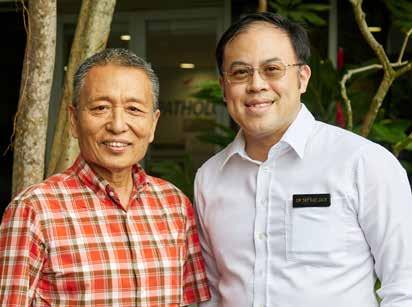
electrical pulses to kill the cancer. The electric current causes irreversible pores to form in the cell membrane. These cells will die and be removed from the body via a process called apoptosis, allowing new cells to grow in their place.
The IRE procedure is performed under general anaesthesia and takes around an hour. In most cases, patients are discharged on the same day. As the prostate will swell for a few days after the procedure, patients will be fitted with a catheter to help them urinate.
IRE is a form of therapy that precisely targets small prostate cancers for destruction without damaging surrounding structures that govern sexual and urinary function. It is suitable for treating not just cancers near the urethra, but also selected early-stage prostate cancer patients with a tumour not bigger than 1.5cm.
Being able to offer a wider spectrum of treatments means that SGH is able to customise treatment to the disease, which can be diagnosed at different stages and
Although Mr Tan Kok Wee’s (above, left) PSA reading was just above 4, indicating low risk of prostate cancer, he opted for treatment because his levels doubled from 2021 to 2022. According to Dr Tay Kae Jack (above, right), “prostate cancer is generally quite slowgrowing but, given enough time, growth will accelerate”.
with cancers of different sizes and locations. Prostate cancer can be treated with surgery to remove the whole gland, radiotherapy, and focal therapy, which uses very high or very low temperatures to kill specific areas of cancerous cells. All these methods, however, risk damaging tissues, nerves and organs around the urethra.
For instance, focal cryotherapy, which freezes the cancer at -40°C, is more suitable for the outer area of the prostate, but up to half of cancers occur in the central area of the prostate, said Dr Tay. “With focal IRE, there is more comprehensive treatment for cancer in all locations within the prostate to provide personalised care for our patients,” he added.
Prostate cancer is the leading cancer among men. According to the latest Singapore Cancer Registry numbers, there were about 7,000 newly diagnosed cases of prostate cancer between 2017 and 2021, up from about 5,000, between 2013 and 2017.
SGH Prostate Centre
The SGH Prostate Centre was established in March 2023 to provide a one-stop service for the care and management of prostate-related problems such as benign prostate hyperplasia or enlarged prostate gland. It provides dedicated resources, allowing the multidisciplinary care team to explore new treatments such as IRE and cryotherapy, and to offer a comprehensive suite of clinical services specifically for prostate-related conditions. Prostate problems form over 40 per cent of the patient load seen by SGH urologists.
PHOTO: VERNON WONG
Serving jumbo tasty meals
Patients have given the thumbs-up to three new food items that use sauces and recipes from restaurant and food group, Jumbo.
by Wong Sing Wei
When meals must conform to strict hospital dietary requirements like using less salt, less sugar or less oil, taste can take a hit.
However, a collaboration between Jumbo Group and Singapore General Hospital (SGH) to create tasty hospital dishes with dietitians’ input is seeking to change that perception.
“We had been thinking about how to elevate the variety and quality of food that we serve to our patients. Later, the idea to work with Jumbo Group was put forth to SGH Food Services in September 2022, with the aim to create some excitement for our patients,” said Mr Tan Jack Thian, Group Chief Operating Officer, SingHealth, and Chief Operating Officer, SGH.
For Mr Ang Kiam Meng, Group Chief Executive Officer and Executive Director, Jumbo Group, partnering SGH offers the group a chance to do its part in making a difference to patients’ well-being. “Food is medicine. It is essential for both physical and mental health. Playing a role in a patient’s recovery process gives meaning to our work,” said Mr Ang, who added that Jumbo’s aim to make healthy meals enjoyable for patients will aid in providing the nourishment they need to recover.



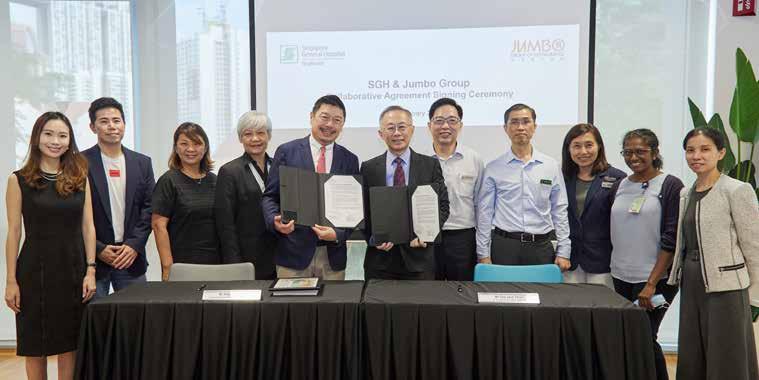
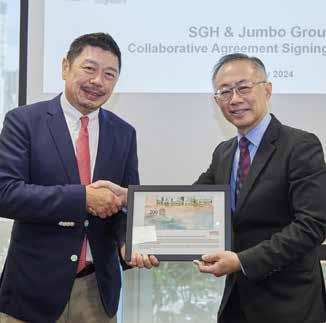
The two were speaking at the signing of their collaborative agreement in January 2024.
After months of preparation, three new menu selections were launched and served to patients in October 2023. Feedback from patients about the dishes — Steamed Fish with Jumbo Seafood Chili Crab Sauce, Steamed Fish with Jumbo Seafood Nonya Sauce, and Chao Ting Teochew Pao Fan —
has been positive. The sauces belong to the restaurant group’s signature items, while the Pao Fan soupy rice porridge is from its specialty food outlet.
Creating new menus for patients is no easy task. SGH’s kitchen serves some 2,000 meals three times a day, catering to patients who range in age from young adults to the very old, and who have a wide range of medical conditions. Besides dietary and religious considerations, the texture of the
The Jumbo dishes are served according to a schedule:
Steamed Fish with
“Playing a role in a patient’s recovery process gives meaning to our work,” says Mr Ang Kiam Meng (left). Mr Tan Jack Thian (right) adds that the idea to work with Jumbo Group was put forth to SGH Food Services in September 2022, “with the aim to create some excitement for our patients”.
food served must be safe for patients. Food that is too hard, too soft, contain bones or hard shell can lead to choking.
In partnering Jumbo, the chefs from SGH Food Services also have to contend with ensuring that the quality of the food served with Jumbo’s sauces maintain the quality consistent with the group’s brand. At the same time, the brand’s signature dishes like Jumbo Chili Crab had to be adapted for patients. So, instead of crab, fish is used.

08 InFocus
New dishes (clockwise from top): Chao Ting Teochew Pao Fan, Steamed Fish with Seafood Nonya Sauce, and Steamed Fish with Seafood Chili Crab Sauce.
SGH Food Services staff preparing meals that use products from the Jumbo Group.
Chao Ting Teochew Pao Fan
Steamed Fish with Jumbo Seafood Chili Crab Sauce
Jumbo Seafood Nonya Sauce
Fridays Thursdays Wednesdays Thursdays Wednesdays Mondays




09 InFocus
He lives biosafety
Mr David Lam is not only a pioneer in the area of biosafety, but is also the first and only biosafety professional from Singapore on the World Health Organization’s international advisory panel on the speciality.
by Candice Cai
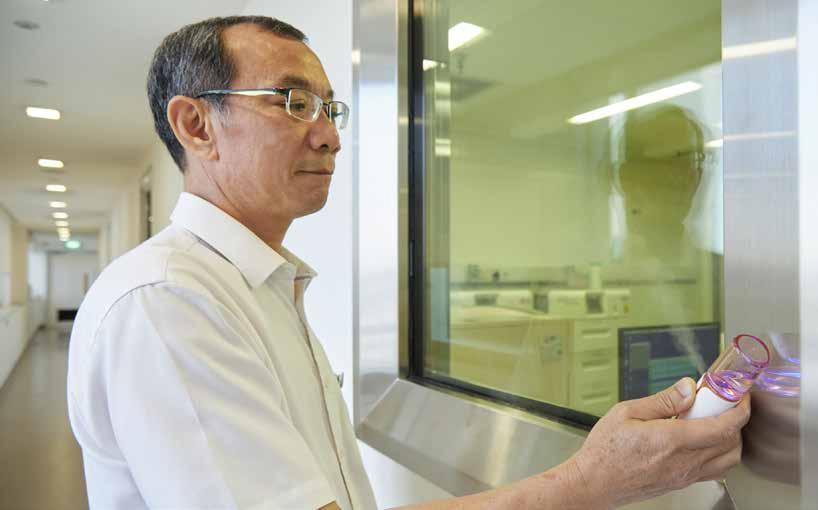
When Biological Safety Assistant Director
Mr David Lam joined
Singapore General Hospital (SGH)
15 years ago, it was mostly to help the hospital consolidate and move its many diagnostic laboratories into Academia, a new two-tower building to house the pathology division as well as clinical and administrative offices.
Not only were the laboratories dispersed in different buildings on the sprawling SGH Campus, the team tasked with the move also needed to ensure that the more than 120,000 samples — in containers of different sizes and shapes, requiring different storage conditions, anything from -80°C to room temperature — were moved safely and without incident.
“Some of these were very high-risk pathogens, and we could not afford to have an accident transporting them and have these biological agents spilt on the road. So the main job was to contain all this biological material

People ask me where I get my job satisfaction. It’s when I see staff enjoying working in a safe environment — that’s when I know my job is done.
Mr David Lam Assistant Director (Biological Safety), Department of Workplace Safety and Health, Singapore General Hospital
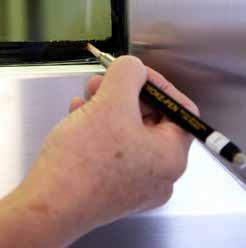
from getting out of intended areas, basically the lab,” said Mr Lam.
He has come a long way since. Today, Mr Lam, 61, has built a wealth of knowledge and experience in the discipline, and has even been acknowledged by the World Health Organization (WHO) as an expert in the field.
The native Hong Konger literally stumbled into the job when he was working as a project manager for a biomedical research firm in Singapore. When his then boss asked if he could take on the role of biosafety officer for a project, Mr Lam recalled with a chuckle: “My exact response to him was, ‘What do you mean by biosafety officer?’” He decided to take on the task anyway — and the rest is history.
To become a biosafety professional, Mr Lam attended a five-day course overseas but found that theory and practice were quite different. “When I was stuck, I had to go around and look for people more knowledgeable than I was to ask for their opinion,” he said. Coming onboard SGH, he also learnt on the job. “Working in SGH gave me the opportunity to polish my skills. Every case is unique, and you get to practise a lot. It’s a different kind of skillset,” he said, describing work in SGH as a once-in-alifetime experience. “People ask me where I get my job satisfaction. It’s when I see staff enjoying working in a safe environment — that’s when I know my job is done.”
His skills and experience were tested again during the COVID-19 pandemic. A shortage of beds at the start of the crisis led to SGH taking delivery of 50 containers to be used as temporary isolation facilities. He joined a team assigned to get the containers ready within weeks. “We didn’t know what we were up against as we did not get to see all the containers until the day they arrived,”
Mr Lam said, adding that the team also faced physical challenges, like having to work inside the stuffy containers under intense heat as airconditioning had not been installed yet.
Even as the world settles down to a new normal living with the virus — and anything else that may emerge — Mr Lam’s work is no less hectic as he consults on biosafety matters ahead of the opening of two new buildings, the SGH Elective Care Centre and National Dental Centre Singapore, and the SGH Emergency Medicine Building. He is no stranger to megaprojects, as he was with the team planning and designing the new Sengkang General Hospital, particularly its specialised isolation and endoscopy facilities, from 2013–2018.
Mr Lam was also named to the WHO’s international advisory panel as a biosafety expert — the only one from Singapore, and one of four from Asia (Indonesia, Thailand and China). “The group advises WHO and other international organisations on issues from biosafety risk assessment to transfer of biological agents. It encompasses containment, disinfection, decontamination and all the new biosafety-related technologies,” he said.
Now a Singapore citizen, Mr Lam spends his leisure time with his wife and two daughters, and occasionally on his carpentry hobby, making items like shoe boxes and shelves.
However, it is obvious his life revolves around biosafety. He issues stop-work orders when he sees unsafe practices, even for SGH’s administrative offices. He reads ingredient labels on disinfectants in supermarkets to see if they would be able to “kill everything” as claimed. On the bus, he observes how fellow passengers wear their surgical masks — some below the nose, and some with an N95 on top of a first mask.
“I think it’s an occupational hazard,” he said.
10 People
Mr David Lam uses a vapour spray (above) and smoke pen (left) to check that air is not escaping from a negative-pressure lab. These labs are used to study contagious and dangerous bugs like tuberculosis, anthrax, and coronaviruses that caused SARS and COVID. He typically tests the labs — which he helped design — once a year for MOH certification.
SOTOHP NONREV: W O N G
Comfort always
Dr Lim Zhen Wei enjoys practising real-time medicine where his pain management treatments benefit patients swiftly.
by Goh Bee Lian
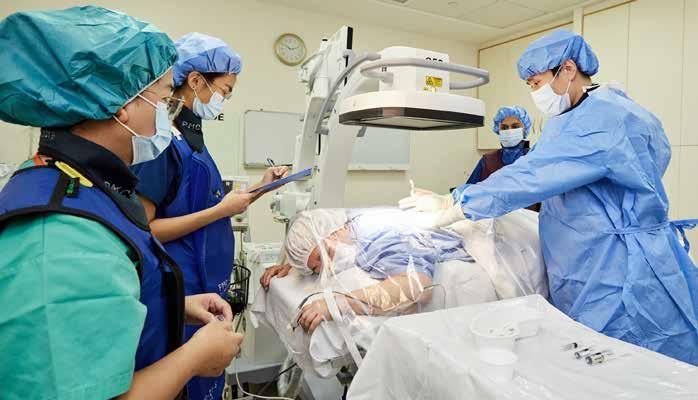
Doctors cure sometimes, treat often, but comfort always — and guided by that saying, Dr Lim Zhen Wei made the decision early in his career to practise anaesthesiology — and later to specialise in pain medicine.
The discipline fascinated him as he viewed anesthesiologists as being able to exercise exact control over the human body, and to practise medicine with what he describes as instant benefits for his patients.
“Anaesthesiologists play a very important role in making patients comfortable and lessening anxiety during and after surgery by precisely managing human physiology like blood pressure, breathing volume, and body temperature,” said Dr Lim, who is Consultant, Department of Pain Medicine, Pain Management Centre (PMC), Singapore General Hospital (SGH). “Pain medicine is a natural extension of practising anaesthesiology where I lessen patients’ pain, frequently after surgeries or secondary to another disease.”
Dr Lim feels a great sense of achievement when he can help his patients overcome their pain. “I once treated a 60-year-old who was limping into the procedure suite in the morning but was hopping out of PMC by lunchtime,” he said.
His patients are a diverse group, ranging from teenagers to nonagenarians, with complaints such as painful joints in their limbs and even the spine. Their pain might have resulted from sports activities, accidents, or just age-related wear-and-tear.
Most, however, seek help to manage their pain because they are not keen on more invasive treatments like surgery.
Dr Lim recalled a female patient in her late 60s with osteoarthritis in both knees. “She was petrified at the idea of undergoing surgery. I did a right knee genicular nerve ablation treatment and her knee pain was reduced substantially,” he said.
Dr Lim used the same treatment on a younger man in his early 40s who also had knee pain. In his case, jogging, golf and other activities had worn out his knees, causing pain. The man did not want surgery as he felt his symptoms were relatively mild.
After positioning a needle next to the nerve causing pain and numbing it with state-ofthe-art cooled radio frequency ablation, the patient was able to return to what he was doing before.
“Numbing the nerve — a pure sensory nerve that does not supply any motor function — reduces the pain,” said Dr Lim.
For many patients, having the pain reduced to a level that enables them to get on with life is sufficient. Making the patient more comfortable, even without correcting the underlying disease, is vital. The natural reaction of someone with a painful left knee is to use their right knee more to avoid putting pressure on the painful knee. But over time, the patient could start feeling pain in the right knee.
“It is important that we treat the pain early so that the patients can continue to maintain a balanced posture. It slows down the progression of the disease. For many patients, that is enough,” said Dr Lim.
Dr Lim sees the practice of medicine as both an art and science. So perhaps it is not surprising that he should have an interest in horology, the art of making clocks and watches.
“Other than good clinical acumen and skills, a good doctor must also be able to build rapport and make patients feel at ease. With advances in AI (artificial intelligence) and technology replacing many things in our lives, a good horological creation will remain relevant, just like a good doctor-patient therapeutic relationship, which cannot be replaced by AI,” he said.
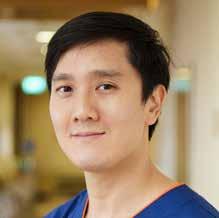
Pain medicine is a natural extension of practising anaesthesiology where I lessen patients’ pain, frequently after surgeries or secondary to another disease.
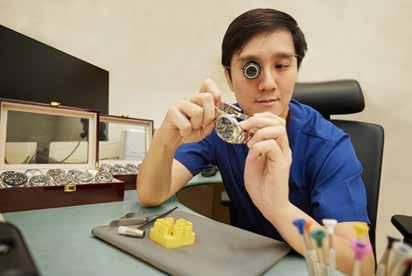 Dr Lim Zhen Wei Consultant, Department of Pain Medicine, Pain Management Centre, Singapore General Hospital
Dr Lim Zhen Wei Consultant, Department of Pain Medicine, Pain Management Centre, Singapore General Hospital
Dr Lim, who shares young children — a girl and boy, aged five and two respectively — with his teacher wife, also enjoys travelling as a family. “Travelling helps us understand the world around us and gain perspective on our own lives by seeing what others are going through. It truly is another form of education. Most importantly, it makes memories that last a lifetime.”
11 People
Dr Lim Zhen Wei performs a staged procedure to dull pain in the spine. The nurses and radiographer wear protective vests as a fluoroscope, essentially an x-ray, is used to help pinpoint the exact area of pain.
Dr Lim Zhen Wei has a keen interest in horology, the art of making clocks and watches. “With advances in AI and technology replacing many things in our lives, a good horological creation will remain relevant, just like a good doctor-patient therapeutic relationship, which cannot be replaced by AI.”
PHOTOS: VERNON WONG

GPs can book SOC appointments for patients directly
A new SingHealth initiative connects healthcare providers for a smoother patient journey and enhanced continuous care from neighbourhood to hospital.
by Vicki Yang
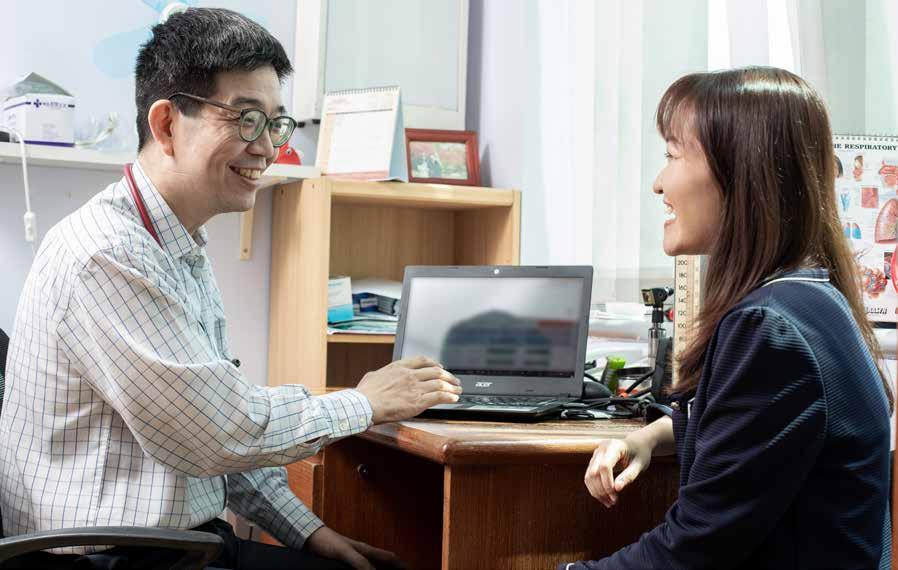
With Partners Buddy, GPs like Dr Lee Tzu Hooi (with Ms Ng Hwee Sian) can make appointments directly on SGH's online appointment system for his patients.
To refer their patients to Singapore General Hospital (SGH) specialists, general practitioners (GPs) can either call or email the hospital to make an appointment. The patient then attends his appointment, with a physical copy of his referral letter. After examining the patient, the SGH specialist might order blood tests and other investigations, and the patient then needs to return for another appointment to review the results and receive the management plan.
To facilitate this process, SGH launched a SingHealth service in late 2022 known as Partners Buddy to allow GPs to directly access the SGH appointment system and to upload relevant medical information. This approach allows patients to have more timely care, and also saves them time and costs.
“Partners Buddy operates as a web-based communication platform that allows GPs to refer patients to specialists seamlessly,” said Dr Emily Ho, Senior Consultant, Department of Endocrinology, and Director of PHICO (Population Health and Integrated Care Office) – Clinical Networks, SGH.
“With this system, we can establish a vital closed-loop communication between them that ensures a smooth transition of care back to their primary GP.”
With the Partners Buddy system, the patient does not have to wait days for an SGH appointment date to be confirmed, as the clinic can do so while he is with his GP. The GP or his assistant can directly select the available appointment dates to book the most suitable date and time on SGH’s clinic appointment system. The patient also does not have to worry about losing or forgetting to bring his GP’s referral to his appointment,
IHEALTHIERSG n support of 12 BeWellwithSingHealth
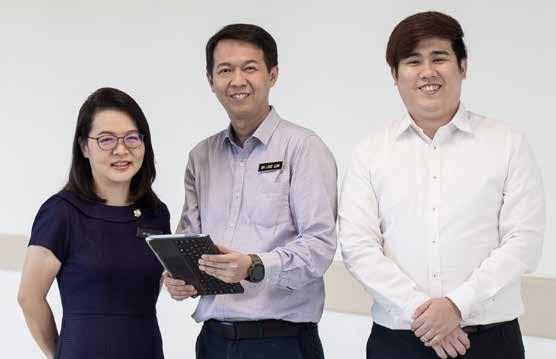
Bringing GPs into care family
GPs mostly find platform easy to use, more efficient, and with few teething issues.
Referring their patients to Singapore General Hospital (SGH) specialists has become much easier and more efficient with Partners Buddy, say general practitioners (GPs) who have used the service.
They can see which medical disciplines, including sub-specialities, are available. Appointments can be confirmed immediately instead both GPs and patients having to wait for SGH’s Specialist Outpatient Clinics to reply on the appointments.
But, said Dr Lee Tzu Hooi of Clifford Dispensary, it is more than that. “Partners Buddy does not mean that patients can get an appointment on the same day. Rather, patients can get an appointment that fits their schedules,” said Dr Lee.
“With Partners Buddy, healthcare becomes more patient-centric, unlike previously, where appointments are based on the doctor’s availability.”
as his GP will key in details of his medical condition to be viewed by the SGH specialist in the hospital clinical system.
An administrative module is available where dedicated hospital triage teams can view the referrals ahead of the appointment and arrange for relevant scans or tests to be done before the consultation, further saving time and costs for the patient.
This open plan strengthens communication and fosters a seamless continuum of care between hospital specialists and GPs. Both the specialist and GP can discuss the patient’s diagnosis, treatment and general condition on the system in real time, and the SGH clinic can discharge the patient back to their referring GP.
Encouraging patients to return to the care of their GPs post-specialist treatment is especially beneficial for those who need ongoing and coordinated care with their chronic conditions. “Partners Buddy allows the GP to track the patient’s journey from the day the appointment is made until he is discharged,” said Ms Hilda Ng, Assistant Director, PHICO – Clinical Networks, SGH.
SGH piloted the programme with selected departments, and this helped the team to fine tune the system. Partners Buddy was then rolled out to the rest of SGH and other SingHealth institutions, including Changi General Hospital, Sengkang General Hospital, KK Women’s and Children’s Hospital, and National Heart Centre Singapore, said Dr Ho, the SGH lead for the project.
For a broader network of care, the team engages GPs island-wide to be involved in Partners Buddy. “Our GP engagement team
actively reaches out to share its advantages and features, while also guiding GPs and their key clinical staff on using the platform,” said Ms Ng Hwee Sian, Assistant Manager, PHICO – Clinical Networks, SGH.
With 124 clinics and 175 GPs on board as of August 2023, feedback on the advantages that Partners Buddy brings towards clinical care has been positive.
This approach is useful for elderly patients, who may forget to tell their caregivers about their upcoming appointments. With Partners Buddy, the identity of caregivers or next-of-kin can be entered into the system for notification purposes. “Previously, there were a lot of phone calls between the clinic, the hospital and the patient, but this makes it faster and easier to support the patient and their caregivers,” said Ms Hilda Ng.
Ongoing feedback from users aids the Partners Buddy team in improving its features. With an ageing population and the prospect of greater complexity of care needed for chronic conditions, the Partners Buddy team aims to broaden and harmonise healthcare in its network. This could translate to new or improved features that capture the patient’s journey across multiple disciplines and institutions should their treatment plan require the expertise of various specialists or other healthcare partners.
“The primary use of Partners Buddy is currently for GPs to refer patients to specialist centres, but we can also look at it as a system for the future, where patients can refer to other services, such as allied health, community

Like other GPs who have used the system, Dr Lee found the Partners Buddy platform relatively easy to use although he faced some teething issues initially. But once he got used to the system, those issues were quickly overcome, he said.
services, or where patients can be referred from these services back to their GP. We are looking into the expansion of Partners Buddy over subsequent phases,” said Dr Ho.
Echoing the sentiments for Partners Buddy to augment an expansive and integrated healthcare landscape, Ms Hilda Ng added: “This is why the programme is called Partners Buddy — healthcare is not just limited to hospitals or GPs, but also community services, for example, as there are many partners that make up healthcare.”

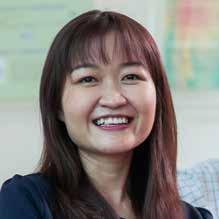
13
(left to right) Dr Emily Ho and Ms Ng Hwee Sian.
The team — including (from left) Dr Emily Ho, Dr Luke Low (Deputy Group Chief Medical Informatics Officer (Continuing Care), SingHealth) and Mr Justin Yeo (Assistant Team Lead Analyst, Synapxe) — took two years to develop Partners Buddy from conception to implementation. Synapxe is the national agency that provides health information and technologyrelated services. GPs, key users of the platform, were asked for their needs to ensure that using the platform would not disrupt their workflow and other processes.

The man took a bus to work every morning. On one journey, he became confused and disoriented. Not knowing where he was, he alighted quickly. Looking around him, he was still not able to recognise his surroundings but managed to call his children to pick him up. After that incident, he became increasingly confused and forgetful. He was later diagnosed with vascular dementia, which is associated with impaired blood flow to the brain.
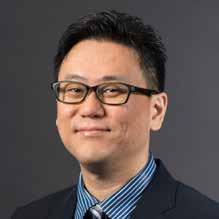
"The ultimate way to reduce
the
risk of vascular
dementia is to
have a healthy lifestyle. At the end of the day, healthy living helps reduce the risk of getting heart disease, reduces the risk of getting a stroke, and reduces the risk of getting vascular dementia,” says Dr Simon Ting.
Vascular dementia does not affect only the elderly
Vascular dementia may rank as the second-most common type of dementia after Alzheimer’s disease, but it is highly preventable with a healthy lifestyle.
by Vicki Yang
vessels; a large, single vessel; or deep areas of the brain. “There are many types of vascular dementia, so the presentation can be quite varied,” said Dr Ting.
While stroke is the main cause — about half of all vascular dementia cases are due to stroke — vascular dementia can be due to other causes; in other words, blockage in the brain not due to stroke and genes. For the former, the patient may have heart valve issues, which lead to a blood clot travelling to the brain and causing a blockage.
While his cognitive decline was sudden and out of proportion, for some patients with vascular dementia, the symptoms can come on more gradually, said Dr Simon Ting, Senior Consultant, Department of Neurology, National Neuroscience Institute (SGH Campus).
Vascular dementia, the most common type of dementia after Alzheimer’s disease, mostly occurs after a stroke. The symptoms of the two neurological conditions may overlap but the latter is more commonly associated with age-related changes in the brain, while vascular dementia can occur at an earlier age, in the 40s. “Stroke is the most common cause of vascular dementia. Physical weakness, slurred speech can come with stroke; typically, within about three months, patients start to show cognitive decline,” said Dr Ting.
Not all patients who suffer a stroke have similar symptoms. Some experience very mild cognitive impairment, while others face major impairments. Under computer tomography (CT) or magnetic resonance imaging (MRI), the brain may show poor blood supply in clusters of small, multiple
Faulty genes can also put people at high risk of vascular dementia. “A condition called CADASIL (Cerebral Autosomal Dominant Arteriopathy with Subcortical Infarcts and Leukoencephalopathy) presents a genetic cause of vascular dementia where the walls of small or mid-sized blood vessels thicken, limiting blood flow,” said Dr Ting.
Another is where a copy of the ApoE4 (apolipoprotein E4) gene is inherited from both parents. “That means both parents have ApoE4, you get both from them, then your chance of developing dementia is eight times higher than those without it, and there’s a chance that your brain will have a lot of ischaemic changes, a lot of vascular changes,” he added.
While both CADASIL and ApoE4 are rare, some people can be more prone to vascular events. In such cases, it is important to bring down the risk of such events by following a healthy lifestyle. “The most important message is that vascular dementia is common because of its direct relevance to vascular risk factors, and the ultimate way to reduce the risk of vascular dementia is to have a healthy lifestyle,” said Dr Ting. “At the end of the day, healthy living helps reduce the risk of getting heart disease, reduces the
risk of getting a stroke, and reduces the risk of getting vascular dementia.”
Vascular dementia is related to the socalled vascular burden or risk factors affecting the vascular system — hypertension or high blood pressure, diabetes, smoking, excessive weight, and having a sedentary lifestyle. These conditions can affect or compromise blood circulation to the brain, potentially causing strokes and damage to parts of the brain responsible for certain cognitive functions and, consequently, vascular dementia.
While the condition cannot be cured, early diagnosis and treatment can slow or even stop vascular dementia from worsening.
Common signs of vascular dementia
Memory lapse
Personality changes
Mood changes
Poor concentration, coordination, planning and attention
Increasing difficulty with daily activities
Lower risk through diet and lifestyle
Stay socially active
Keep chronic diseases like diabetes and high blood pressure under control
Quit smoking
Limit intake of fat, sugar and sodium
14 HealthWatch
Caffeine fix for Parkinson’s disease
Recent study by NNI shows coffee consumption reduces Parkinson’s disease risk in people genetically predisposed to the ailment.
by Chua Kim Beng
Coffee lovers must be rejoicing now that a study by the National Neuroscience Institute (NNI) has shown that downing just two cups of kopi a day can reduce the risk of Parkinson’s disease (PD) by four to eight times in people with Asian gene variants linked to the condition.
What is PD?
PD is a progressive disorder that affects the nervous system. Although it is most commonly associated with tremors — rhythmic shaking of a limb, often at the hand or fingers — it can manifest in other ways: slowed movements, loss of automatic movements, rigid muscles, and poor balance.
PD is the fastest growing neurodegenerative condition around the world. A recent study by NNI showed that 26 per cent of the local older population exhibit mild Parkinsonian signs.
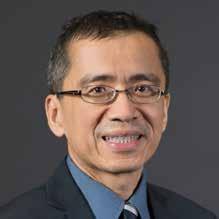
Research impetus
Professor Tan Eng King says that the epidemiological observation does not differentiate whether it is the caffeine only or caffeine plus something else, such as other antioxidants, in coffee and tea that is imparting the neuroprotection.
Professor Tan Eng King, Deputy Chief Executive Officer (Academic Affairs) and Senior Consultant, Department of Neurology, NNI, and the study’s principal investigator, shared that caffeine is known to decrease inflammation of neurons in the brain. “Coffee and tea are the most widely consumed beverages globally and here in Singapore,” he added. “Because these beverages have been linked to neuroprotection, this provided the impetus for us to investigate its interaction with Asian-specific PD-linked gene risk variants in our population.”
The key question, Prof Tan said, is whether caffeine consumption can reduce the PD risk posed by these genetic variants. If the study showed that link, then lifestyle modification can be added to the arsenal of weapons to combat PD. “Tea and coffee are readily available and culturally accepted in most Asian societies, and consuming caffeine within normal limits offers an easy, pleasant and sociable way for people to potentially reduce their risk of PD.”
Study details
There are two known Asian gene variants that occur most frequently in East Asians. Up to 10 per cent of the Singapore population

carry one of these variants. The study, which involved 4,488 subjects, showed that people carrying these variants have a 1.5 to 2 times higher risk of developing PD.
The subjects’ average daily caffeine intake was 448.3mg among PD cases and 473.0mg in the healthy controls. This amount of caffeine is found in four to five cups (235ml per cup) of Western-style brewed Arabica coffee beans or two cups of traditional Singapore kopi made from Robusta coffee beans, which have higher caffeine content than Arabica coffee beans. (400mg of caffeine a day is generally regarded as safe for most healthy adults.)
Higher doses of caffeine appeared to confer stronger neuroprotection, but even subjects who drank less than 200mg of caffeine per day still reduced their PD risk. In fact, tea and coffee drinkers who carry the PD gene lower their risk of getting PD to below that of non-caffeine drinkers who do not carry the gene.
Results of the study were first revealed at the 10th Singapore International Parkinson Disease and Movement Disorders Symposium, which was held in September 2023.
Next steps
So if a person does not have the gene variants, will dosing on coffee keep PD at bay? Based on current epidemiological evidence, it is useful to take coffee and tea in moderate amounts regardless of PD risk; in those at high risk such as gene carriers, it is even more useful. Prof Tan added that the epidemiological observation does not differentiate whether it is the caffeine only or caffeine plus something else, such as other antioxidants, in coffee and tea that is giving the protection.
But the next step for him and his team, shared Prof Tan, was “to conduct biological studies in human cell and animal models to decipher the underlying mechanisms, and also to conduct more clinical studies to examine the caffeine interaction with other genetic variants”. He would also like to conduct further studies that follow patients over a longer period of time. “This will help to determine the exact relationship between doses of caffeine consumption and progression of PD and other related diseases. With more information, we can then provide better management protocols for patients and those at risk of getting PD,” he said.
15 HealthWatch
Nutrition in palliative care
Understanding
and meeting
patients’ nutrition and hydration needs and wishes is a key aspect of palliative care.
by Chua Kim Beng
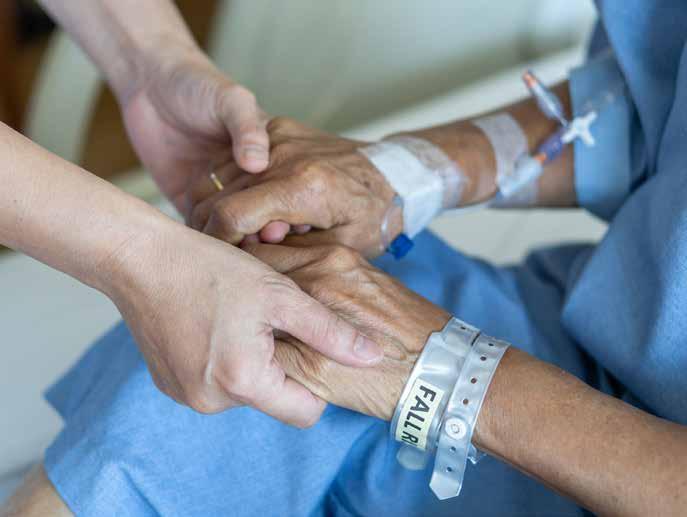
For palliative patients in endof-life care, does nutrition still play a part in their therapy? The answer from Dr Zhuang Qingyuan, Consultant, Division of Supportive and Palliative Care, National Cancer Centre Singapore (NCCS), is a resounding “yes”.
“Nutrition is an important part of palliative care,” Dr Zhuang stressed. He explained that it is essential to have a carefully considered nutrition plan and communicate it to patients and their family members with empathy so that they understand the goals of the plan and know what to expect.
Nutrition is an important and emotive issue because it is not just about calories. This is because eating and drinking are often social activities and thus factors in maintaining familial bonds and a sense of normalcy. For some people, food is their nonverbal way to express love and care; for others, many dishes and drinks hold cherished memories and special meaning.
“We often encounter family members who are concerned whether a loved one in palliative care would be hungry or thirsty,” said Dr Zhuang.
Defining end of life
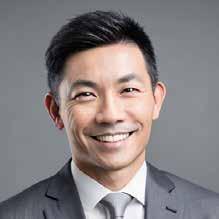
“End of life is commonly referred to as the last year of life. It’s important to bear in mind that a prognosis is actuarial and not definite. Hence, even in the last year of life, treatments do continue with the intent to prolong life, if it aligns with the patient’s and family’s goals,” Dr Zhuang said. Nutrition and hydration at this stage of life are considered medical interventions to prevent or treat, for example, malnutrition and dehydration. Nutrition recommendations are made after thorough assessment by the medical team. These recommendations should be based on the patient’s wishes and therapy goals, and also what is realistically achievable and medically feasible (see sidebar).
Nutrition and hydration for patients in palliative care are considered medical interventions, explains Dr Zhuang Qingyuan.
For his family’s sake
A patient’s preference for hydration and nutrition can become complicated and involve considerations of family wishes. Dr Zhuang spoke about one such patient.
“I had a young patient who was terminally ill and had to be on total parenteral nutrition,” he recalled. Total parenteral nutrition is a method of feeding that bypasses the gastrointestinal tract and delivers nutrition through a vein.
The patient confided in Dr Zhuang that he never wanted to be kept alive artificially with nutrition — the patient knew how advanced his cancer was and had accepted that death was imminent. However, the patient could see that his loved ones were struggling to come to terms with his condition and worried about him getting enough to eat and drink.
For the sake of his loved ones, the patient asked to be kept indefinitely on artificial nutrition, which was provided till he passed away in the hospital. “This was a memorable patient because he decided to be on artificial nutrition despite his wishes as an ultimate expression of sacrifice and love for his family,” he shared.
Nutritional needs change
A decrease in appetite and thirst — and thus body weight — is natural and to be expected when a patient reaches end of life; it is a sign of the body slowing down. The patient’s alertness fades as metabolism slows down and nutrition needs diminish. This is part of the ongoing disease process and a natural progress of deterioration and demise.
Overzealous artificial nutrition and hydration may result in more harm, especially if the body is unable to tolerate the increase in fluid volume. These may present as swollen peripheries, discomfort from build-up of fluids in the lungs causing breathlessness and increased chest secretions. Delivering tube feeding against wishes may also result in oropharyngeal discomfort and unnecessary bed-restraints.
16 HealthWatch
Scratch that itch
Chronic pruritus is a skin condition that afflicts mainly the elderly and can impact their quality of life.
by Candice Cai, with information by SingHealth Polyclinics
What is chronic pruritus?
Chronic pruritus (CP) is defined as a prolonged itching of the skin that persists for more than six weeks.
Who is most susceptible?
Prolonged itching is the most common skinrelated complaint among the elderly who are aged 65 and older, as ageing often leads to dry skin and changes to the skin nerves. The prevalence of CP in an inpatient geriatric patient population in Singapore is reported to be 48.5 per cent.
Causes of CP
The causes of CP are usually multifactorial and often misunderstood, which makes it more challenging to diagnose and treat. Symptoms may recur, which leaves the patient feeling frustrated. They are then driven to seek temporary relief of the symptoms rather than regular preventive management of the condition.
Impact of CP
Prolonged itching can interfere with one’s sleep, exercise, hobbies and social life. The condition has also been found to result in anxiety and depression. Many patients may rub or scratch the affected area, causing injury to the skin, or resort to frequent washing of the site to find temporary relief. They may also change their eating habits and adopt certain diets in an attempt to relieve the itch.
Treatments
The treatment for CP involves both shortand long-term approaches. The usual practice involves treating the acute symptoms with oral antihistamines, oral steroids, or topical steroid creams.
Most patients in Singapore with CP are treated with sedating antihistamines. However, these can have negative consequences, such as the increased likelihood of falls and reduced concentration at work.
Non-sedating antihistamines are safer, but curbing the symptoms requires long-term use, which may add to the pill burden of the elderly.
Key findings from a local study
The first local study by SingHealth Polyclinics of 13 patients with CP was conducted in 2021. The results of the qualitative research found that the elderly respondents perceived the condition as a chronic “problem”, rather than a disease that can be cured. Their perceptions of the causes were also diverse due to the lack of clear explanation by their doctors. In addition: Patients alluded to emotional disturbances

such as feeling depressed, frustrated, embarrassed, angry, guilty, fearful and sad.
CP led to isolation and avoidance behaviours (e.g. some patients would confine themselves solely to indoor activities).
Patients also reported sleep disruption and dermatological complications (e.g. scratching until skin is broken, skin thickening or scarring).
To cope with their condition, they sought help from friends, consulted multiple doctors, or used alternative therapies.
The results of the findings suggest that in order to prevent possible maladaptive behaviour of patients — such as frequent doctor changes that result in a higher healthcare cost — a more person-centric approach is recommended to provide personalised care to patients.
Following the above study, SHP has since developed an Itch Assessment

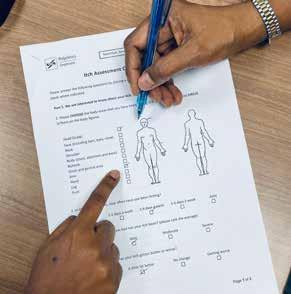
Questionnaire (IAQ), which will be used for the next study to assess the magnitude and morbidity of itch in the local population. Subsequently, IAQ will be used to monitor patient symptoms and severity in clinical care. The recruitment for the study began in the second half of 2023, and will include 250 adults.
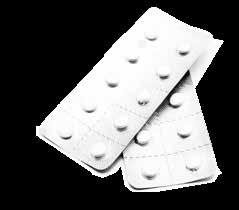
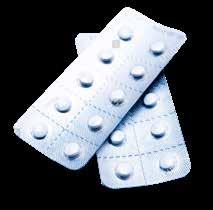
17 AtAGlance

Can going to concerts cause hearing loss?
My teenage daughter likes going to concerts but I’m afraid her hearing will get damaged from being exposed to the loud music of singers like Taylor Swift and BTS. She experienced ringing in the ears after one concert but was fine after a while. Is her hearing damaged? And is it permanent?
Sound level is measured in decibel (dB). The average loudness or intensity of sound is about 60dB for regular person-to-person conversations, 80–100dB in cinema halls, and 100–120dB at concerts. But intensity is not the only factor at play when it comes to hearing damage from loud sounds — duration of exposure to the sound is also important.
It takes about eight hours of constant exposure to sound with an intensity of, say, 80dB, before some hearing damage takes place. For every 3dB increase in intensity, exposure time to the sound must be halved. This means that when the sound intensity is increased from 80dB to 88dB, only four hours of exposure is needed before some damage sets in. At 100dB, which is very loud, this goes down to three hours.
The ringing or muffled sounds that a person sometimes experiences after a loud concert usually go away within 48 hours.
The microscopic auditory hair cells in the inner ear sway when sound waves enter the ear. When the sound is very loud, the cells take more time to straighten. When the sound is too loud, the hair cells may be unable to straighten back and become irreversibly damaged. Damaged hair cells result in decreased hearing sensitivity. People with some damaged hearing, for instance, are often unable to distinguish between high-frequency sounds like ‘s’ and ‘th’.
Hearing loss may occur more commonly in older people — about 10 per cent of people above the age of 65 and 30 per cent of those above 80 have hearing loss — but it is not just an elderly problem.
Using ear buds to listen to music at full blast can mean being exposed to sound levels of about 100dB. With noise cancellation features in more advanced devices, keeping the volume at 60 per cent can allow listeners to enjoy their music for a longer period while protecting their hearing.
Dr Vanessa Tan Consultant, Department of Otorhinolaryngology-Head and Neck Surgery; Director, Centre for Hearing and Ear Implants; Singapore General Hospital

For more on this issue, click on https://for.sg/ perfectly-imperfecthealthhearing or scan the QR code to listen to the ‘Hearing Loss’ episode of SGH’s podcast, Perfectly Imperfect Health

Can varnish trigger asthma attacks?
I was diagnosed with asthma a few years ago, and have a slight allergy to animal dander such as cat fur. Recently, during my home renovation, I started wheezing and needed my inhaler, seemingly whenever I was around varnish. Can substances such as varnish trigger asthma?
Unfortunately, there are many environmental exposures that can trigger asthma symptoms in susceptible individuals. These exposures may act as allergens or irritants. An allergen is a substance that triggers the immune system, leading to an allergic reaction. An irritant is a substance that does not trigger the immune system but can irritate the body, leading to inflammation.
Common allergens include dust mite, mould, animal fur, cockroach and pollen. Other allergens include enzymes, flour, latex, animal protein, certain chemicals, and medications such as aspirin. Irritants include smoke, environmental pollution, cleaning products, and solvents.
You should try to avoid substances that trigger your asthma symptoms. Skin prick tests and blood tests for some of the allergens are available, but it is usually not practical to test for all possible allergens.
Dr Tay Tunn Ren Senior Consultant, Department of Respiratory and Critical Care Medicine, Changi General Hospital

18 AskOurExpert
Q uestion & A nswer
that a study by KK Women’s and Children’s Hospital, Singapore General Hospital, National Centre for Infectious Diseases, and the Ministry of Health found that COVID-19 vaccination (mRNA-based COVID-19 vaccine) taken during pregnancy was associated with a reduced risk of COVID-19 infections among infants up to six months of age.
Maternal COVID-19 vaccination — for those who complete three doses of vaccination — was found to be up to 44.4 per cent effective in protecting infants against SARS-CoV-2 infection up to six months after birth. Protection was not found in infants whose mothers were vaccinated prior to their pregnancies.

that some patients waiting for a bed in Singapore General Hospital (SGH) may have to be housed in a temporary holding area? The temporary area, which can hold more than 20 beds, is used whenever the hospital faces a bed crunch.
SGH’s Emergency Department (ED) has experienced heavy patient visits, with the number surging during periods of widespread infections — not just for COVID-19, but also seasonal influenza and other respiratory infections. During periods of high COVID-19 infections, some regular wards and rooms have to be converted into single-room isolation facilities for infected patients.
Even as the nation returns to normalcy, demand for hospital beds stays high as patients present with complex conditions as well as complications from chronic diseases. Thus, demand for beds is sustained.
The accommodation at the holding area is basic as it is in the open street level area of the Outram Community Hospital across the road from the ED. Only patients triaged at the ED and found to be in stable condition are housed there while they wait for an inpatient bed.
As with other ED patients, appropriate care and treatment for these patients start once they have been seen by ED specialists.
SGH’s new ED has received temporary occupation permit (TOP) and is expected to be ready by late 2024.
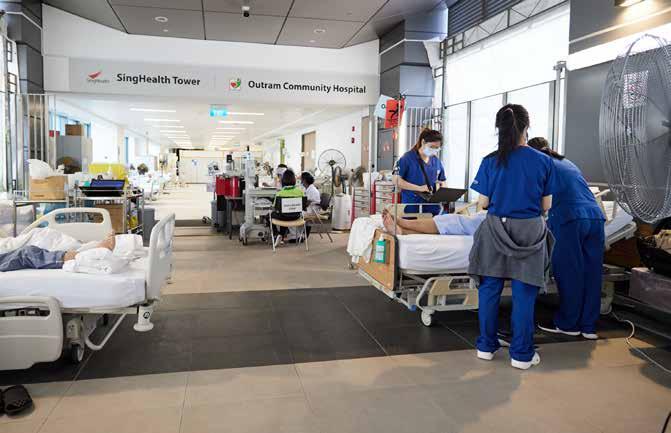

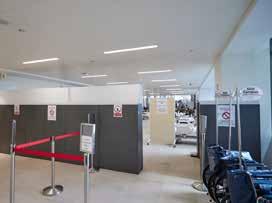
19 DidYouKnow
PHOTOS: VERNON WONG
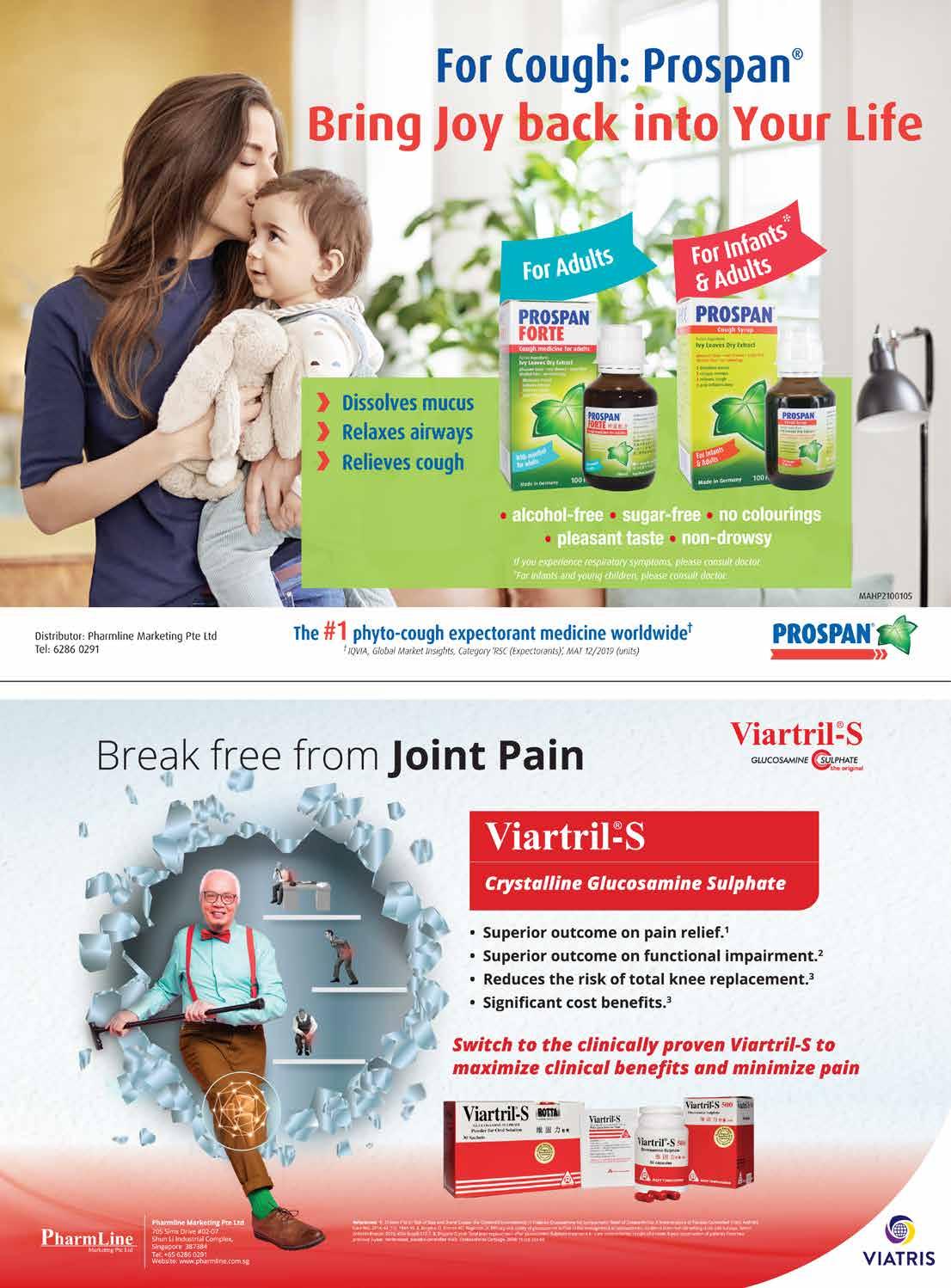

































 Dr Lim Zhen Wei Consultant, Department of Pain Medicine, Pain Management Centre, Singapore General Hospital
Dr Lim Zhen Wei Consultant, Department of Pain Medicine, Pain Management Centre, Singapore General Hospital

























